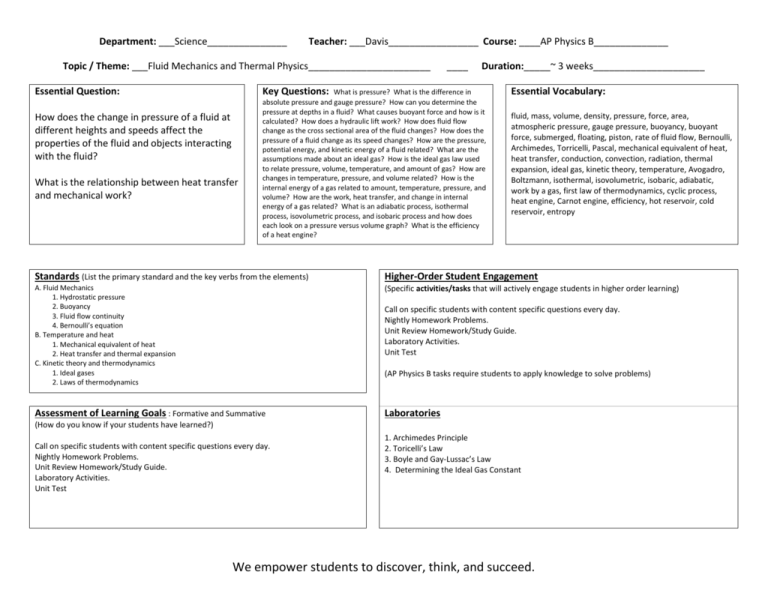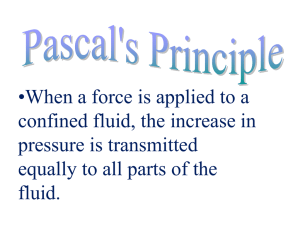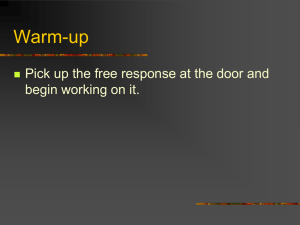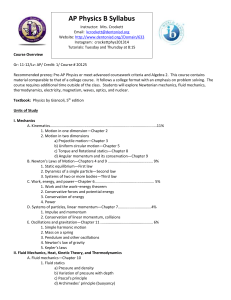Fluids&Thermo - Fulton County Schools
advertisement

Department: ___Science_______________ Teacher: ___Davis_________________ Course: ____AP Physics B______________ Topic / Theme: ___Fluid Mechanics and Thermal Physics_______________________ Essential Question: Key Questions: How does the change in pressure of a fluid at different heights and speeds affect the properties of the fluid and objects interacting with the fluid? What is the relationship between heat transfer and mechanical work? ____ Duration:_____~ 3 weeks_____________________ What is pressure? What is the difference in absolute pressure and gauge pressure? How can you determine the pressure at depths in a fluid? What causes buoyant force and how is it calculated? How does a hydraulic lift work? How does fluid flow change as the cross sectional area of the fluid changes? How does the pressure of a fluid change as its speed changes? How are the pressure, potential energy, and kinetic energy of a fluid related? What are the assumptions made about an ideal gas? How is the ideal gas law used to relate pressure, volume, temperature, and amount of gas? How are changes in temperature, pressure, and volume related? How is the internal energy of a gas related to amount, temperature, pressure, and volume? How are the work, heat transfer, and change in internal energy of a gas related? What is an adiabatic process, isothermal process, isovolumetric process, and isobaric process and how does each look on a pressure versus volume graph? What is the efficiency of a heat engine? Essential Vocabulary: fluid, mass, volume, density, pressure, force, area, atmospheric pressure, gauge pressure, buoyancy, buoyant force, submerged, floating, piston, rate of fluid flow, Bernoulli, Archimedes, Torricelli, Pascal, mechanical equivalent of heat, heat transfer, conduction, convection, radiation, thermal expansion, ideal gas, kinetic theory, temperature, Avogadro, Boltzmann, isothermal, isovolumetric, isobaric, adiabatic, work by a gas, first law of thermodynamics, cyclic process, heat engine, Carnot engine, efficiency, hot reservoir, cold reservoir, entropy Standards (List the primary standard and the key verbs from the elements) Higher-Order Student Engagement A. Fluid Mechanics 1. Hydrostatic pressure 2. Buoyancy 3. Fluid flow continuity 4. Bernoulli’s equation B. Temperature and heat 1. Mechanical equivalent of heat 2. Heat transfer and thermal expansion C. Kinetic theory and thermodynamics 1. Ideal gases 2. Laws of thermodynamics (Specific activities/tasks that will actively engage students in higher order learning) Assessment of Learning Goals : Formative and Summative Laboratories Call on specific students with content specific questions every day. Nightly Homework Problems. Unit Review Homework/Study Guide. Laboratory Activities. Unit Test (AP Physics B tasks require students to apply knowledge to solve problems) (How do you know if your students have learned?) Call on specific students with content specific questions every day. Nightly Homework Problems. Unit Review Homework/Study Guide. Laboratory Activities. Unit Test 1. Archimedes Principle 2. Toricelli’s Law 3. Boyle and Gay-Lussac’s Law 4. Determining the Ideal Gas Constant We empower students to discover, think, and succeed. GPS Standards (Optional) II. FLUID MECHANICS AND THERMAL PHYSICS A. Fluid Mechanics 1. Hydrostatic pressure: Students should understand the concept of pressure as it applies to fluids, so they can: a) Apply the relationship between pressure, force, and area. b) Apply the principle that a fluid exerts pressure in all directions. c) Apply the principle that a fluid at rest exerts pressure perpendicular to any surface that it contacts. d) Determine locations of equal pressure in a fluid. e) Determine the values of absolute and gauge pressure for a particular situation. f) Apply the relationship between pressure and depth in a liquid, ΔP = ρgΔh 2. Buoyancy: Students should understand the concept of buoyancy, so they can: a) Determine the forces on an object immersed partly or completely in a liquid. b) Apply Archimedes’ principle to determine buoyant forces and densities of solids and liquids. 3. Fluid flow continuity: Students should understand the equation of continuity so that they can apply it to fluids in motion. 4. Bernoulli’s equation: Students should understand Bernoulli’s equation so that they can apply it to fluids in motion. B. Temperature and heat 1. Mechanical equivalent of heat: Students should understand the “mechanical equivalent of heat” so they can determine how much heat can be produced by the performance of a specified quantity of mechanical work. 2. Heat transfer and thermal expansion: Students should understand heat transfer and thermal expansion, so they can: a) Calculate how the flow of heat through a slab of material is affected by changes in the thickness or area of the slab, or the temperature difference between the two faces of the slab. b) Analyze what happens to the size and shape of an object when it is heated. c) Analyze qualitatively the effects of conduction, radiation, and convection in thermal processes. C. Kinetic theory and thermodynamics 1. Ideal gases a) Students should understand the kinetic theory model of an ideal gas, so they can: (1) State the assumptions of the model. (2) State the connection between temperature and mean translational kinetic energy, and apply it to determine the mean speed of gas molecules as a function of their mass and the temperature of the gas. (3) State the relationship among Avogadro’s number, Boltzmann’s constant, and the gas constant R, and express the energy of a mole of a monatomic ideal gas as a function of its temperature. (4) Explain qualitatively how the model explains the pressure of a gas in terms of collisions with the container walls, and explain how the model predicts that, for fixed volume, pressure must be proportional to temperature. b) Students should know how to apply the ideal gas law and thermodynamic principles, so they can: (1) Relate the pressure and volume of a gas during an isothermal expansion or compression. (2) Relate the pressure and temperature of a gas during constant-volume heating or cooling, or the volume and temperature during constant-pressure heating or cooling. (3) Calculate the work performed on or by a gas during an expansion or compression at constant pressure. (4) Understand the process of adiabatic expansion or compression of a gas. (5) Identify or sketch on a PV diagram the curves that represent each of the above processes. 2. Laws of thermodynamics a) Students should know how to apply the first law of thermodynamics, so they can: (1) Relate the heat absorbed by a gas, the work performed by the gas, and the internal energy change of the gas for any of the processes above. (2) Relate the work performed by a gas in a cyclic process to the area enclosed by a curve on a PV diagram. b) Students should understand the second law of thermodynamics, the concept of entropy, and heat engines and the Carnot cycle, so they can: (1) Determine whether entropy will increase, decrease, or remain the same during a particular situation. (2) Compute the maximum possible efficiency of a heat engine operating between two given temperatures. (3) Compute the actual efficiency of a heat engine. (4) Relate the heats exchanged at each thermal reservoir in a Carnot cycle to the temperatures of the reservoirs. We empower students to discover, think, and succeed.






